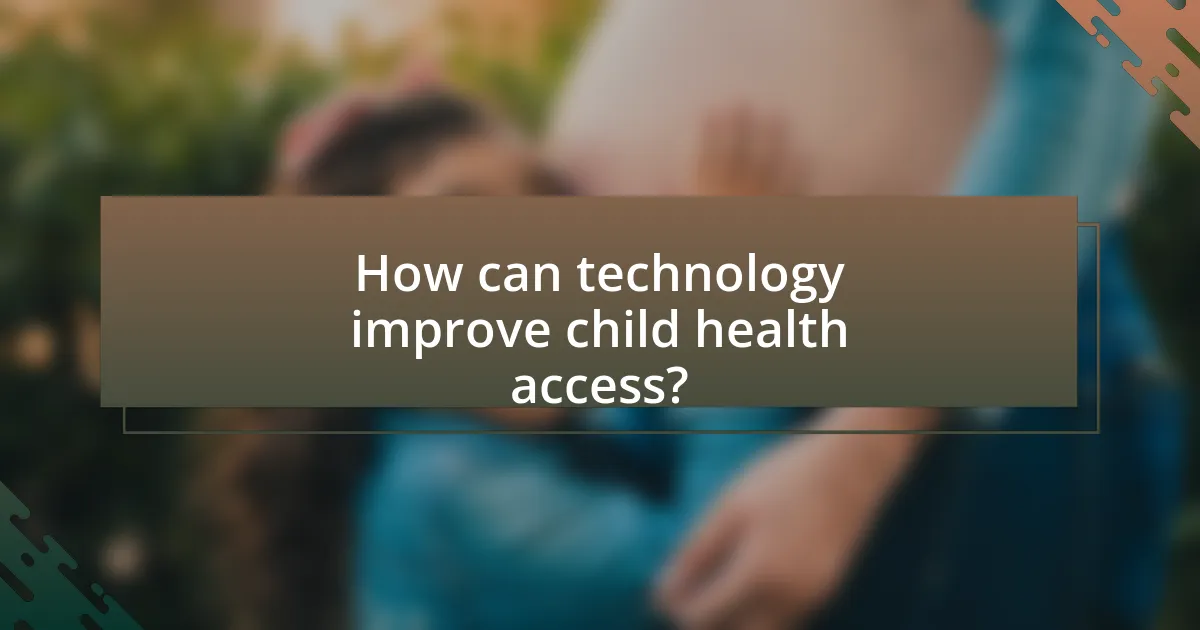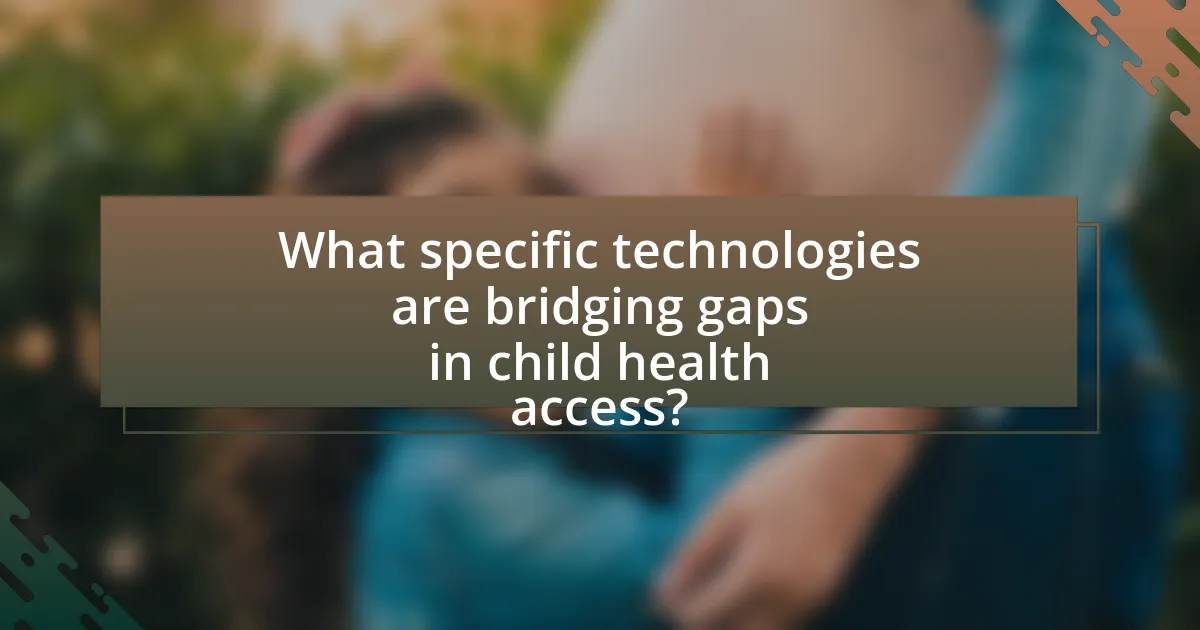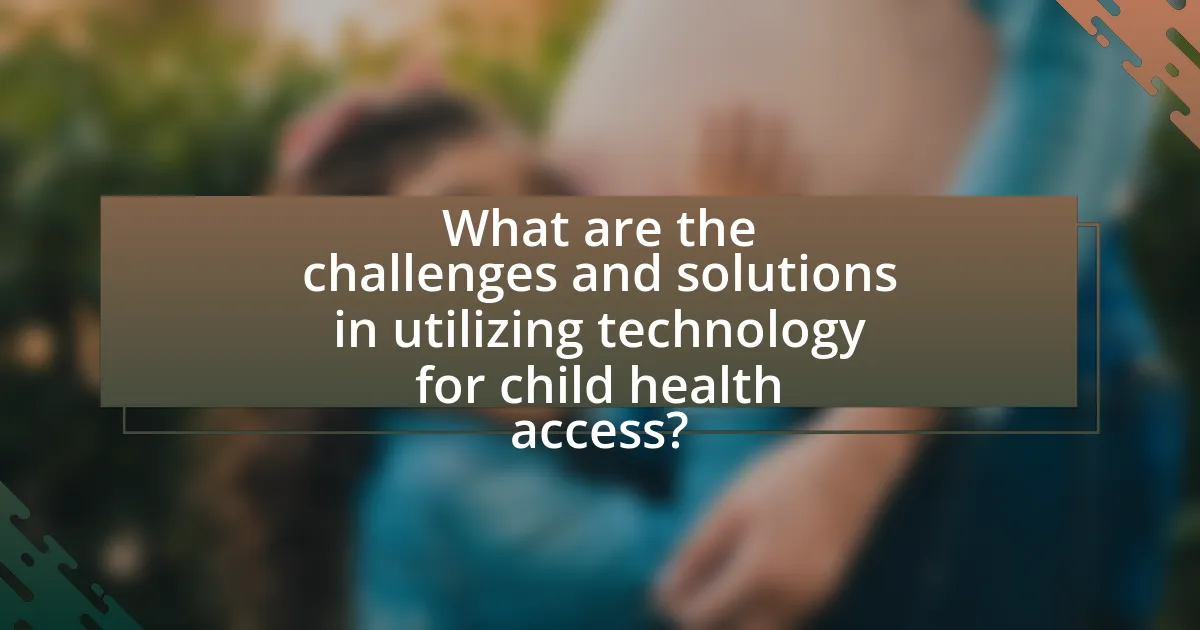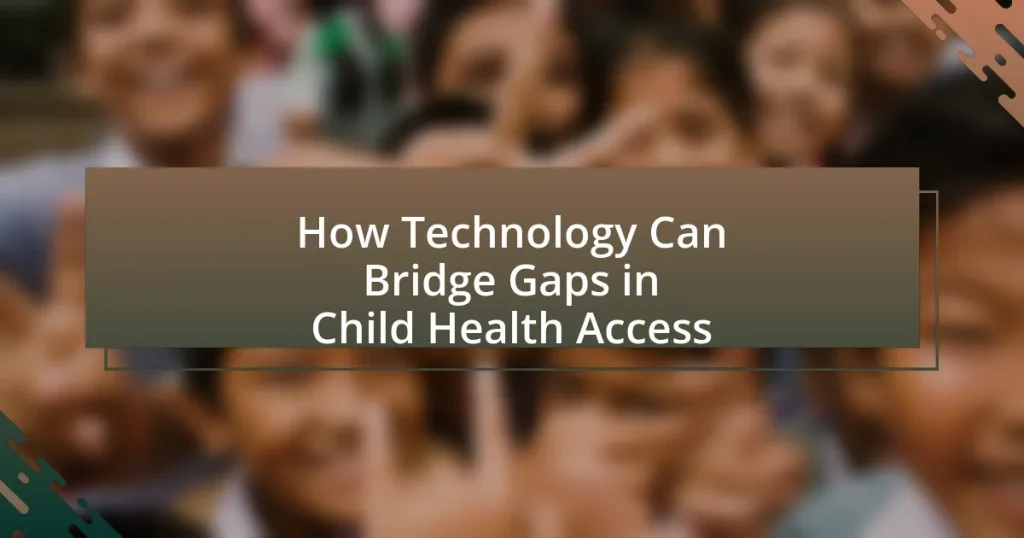The article focuses on how technology can bridge gaps in child health access, highlighting the role of telemedicine, mobile health applications, and electronic health records in improving healthcare delivery for children. It discusses current disparities in healthcare availability, affordability, and quality, particularly in low-income and rural areas, and examines the socioeconomic factors that influence access to child health services. The article also addresses the challenges and solutions related to technology adoption, including digital literacy and infrastructure investment, while exploring future trends such as artificial intelligence and innovations in telehealth that aim to enhance child health outcomes.

How can technology improve child health access?
Technology can improve child health access by enabling telemedicine services, which allow healthcare providers to deliver care remotely. This approach increases access to medical consultations for children in underserved areas, reducing travel time and costs for families. According to a study published in the Journal of Telemedicine and Telecare, telehealth services can lead to a 30% increase in healthcare access for children in rural regions. Additionally, mobile health applications can facilitate health education and monitoring, empowering parents to manage their children’s health more effectively. These advancements demonstrate that technology plays a crucial role in enhancing child health access.
What are the current gaps in child health access?
Current gaps in child health access include disparities in healthcare availability, affordability, and quality. Many children, particularly in low-income and rural areas, face barriers such as lack of transportation to healthcare facilities, insufficient health insurance coverage, and limited access to specialized pediatric care. According to the American Academy of Pediatrics, approximately 5 million children in the United States are uninsured, which directly impacts their access to necessary health services. Additionally, systemic issues like language barriers and cultural differences further hinder effective communication between healthcare providers and families, exacerbating health inequities.
Why do these gaps exist in different regions?
Gaps in child health access exist in different regions primarily due to disparities in economic resources, healthcare infrastructure, and education levels. For instance, low-income areas often lack sufficient healthcare facilities and trained professionals, leading to inadequate medical services for children. According to the World Health Organization, regions with lower GDP per capita typically experience higher rates of child mortality and malnutrition, highlighting the direct correlation between economic status and health outcomes. Additionally, cultural factors and varying levels of health literacy can further exacerbate these gaps, as communities with limited education may not prioritize or understand the importance of child health services.
How do socioeconomic factors influence child health access?
Socioeconomic factors significantly influence child health access by determining the availability and quality of healthcare resources that families can utilize. Families with higher income levels typically have better access to healthcare services, including preventive care, vaccinations, and specialized treatments, compared to those with lower socioeconomic status. For instance, a study published in the Journal of Pediatrics found that children from low-income families are more likely to experience barriers to healthcare access, such as lack of insurance and transportation issues, which directly impacts their health outcomes. Additionally, educational attainment among parents correlates with health literacy, affecting their ability to navigate healthcare systems effectively. Thus, socioeconomic factors create disparities in child health access, leading to unequal health outcomes across different populations.
What role does technology play in addressing these gaps?
Technology plays a crucial role in addressing gaps in child health access by enhancing communication, improving data collection, and facilitating remote healthcare services. For instance, telemedicine platforms allow healthcare providers to reach underserved populations, enabling consultations and follow-ups without the need for travel. A study published in the Journal of Telemedicine and Telecare found that telehealth services increased access to pediatric care by 30% in rural areas, demonstrating the effectiveness of technology in bridging geographical barriers. Additionally, mobile health applications can track immunization schedules and health records, ensuring that children receive timely vaccinations and medical attention. This integration of technology not only improves health outcomes but also empowers families with information and resources, ultimately reducing disparities in child health access.
How can telemedicine enhance healthcare delivery for children?
Telemedicine can enhance healthcare delivery for children by providing timely access to medical consultations and reducing the need for travel. This approach allows pediatric patients to receive care from specialists who may not be locally available, thereby improving health outcomes. For instance, a study published in the Journal of Telemedicine and Telecare found that telemedicine consultations led to a 30% reduction in emergency room visits for pediatric patients, indicating that remote care can effectively address health issues before they escalate. Additionally, telemedicine facilitates continuous monitoring of chronic conditions, enabling healthcare providers to adjust treatment plans promptly based on real-time data.
What are the benefits of mobile health applications for parents?
Mobile health applications provide parents with enhanced access to health information, improved communication with healthcare providers, and tools for tracking their child’s health. These applications allow parents to monitor symptoms, manage medications, and schedule appointments conveniently, which can lead to better health outcomes for children. Research indicates that mobile health apps can increase parental engagement in their child’s healthcare, resulting in more informed decision-making and adherence to treatment plans. For instance, a study published in the Journal of Medical Internet Research found that parents using mobile health applications reported higher satisfaction with their child’s healthcare management.

What specific technologies are bridging gaps in child health access?
Telemedicine, mobile health applications, and electronic health records are specific technologies bridging gaps in child health access. Telemedicine enables remote consultations, allowing healthcare providers to reach children in underserved areas, which is crucial given that approximately 1 in 5 children in the U.S. live in rural areas with limited access to pediatric care. Mobile health applications facilitate health monitoring and education, empowering parents to manage their children’s health effectively; for instance, apps like MyChart allow parents to track vaccinations and schedule appointments. Electronic health records improve care coordination by ensuring that all healthcare providers have access to a child’s medical history, which enhances treatment outcomes and reduces errors. These technologies collectively address barriers to healthcare access, particularly in low-resource settings.
How do wearable devices contribute to child health monitoring?
Wearable devices contribute to child health monitoring by providing real-time data on vital signs, physical activity, and sleep patterns. These devices, such as fitness trackers and smartwatches, enable parents and healthcare providers to track children’s health metrics continuously, facilitating early detection of potential health issues. For instance, a study published in the Journal of Medical Internet Research found that wearable technology can effectively monitor children’s heart rates and activity levels, leading to improved health outcomes through timely interventions. By leveraging this data, caregivers can make informed decisions regarding a child’s health and well-being, ultimately bridging gaps in health access and promoting proactive health management.
What types of data can wearable devices collect?
Wearable devices can collect various types of data, including physiological metrics, activity levels, sleep patterns, and environmental information. Physiological metrics encompass heart rate, blood pressure, and body temperature, which provide insights into an individual’s health status. Activity levels are tracked through steps taken, calories burned, and exercise duration, helping to assess physical fitness. Sleep patterns are monitored to analyze sleep quality and duration, which are crucial for overall health. Environmental information may include exposure to pollutants or UV radiation, contributing to a comprehensive understanding of health influences. These data types are essential for monitoring health and wellness, particularly in children, as they can inform healthcare providers about potential health issues and guide interventions.
How can this data be used to improve health outcomes?
Data can be used to improve health outcomes by identifying trends and disparities in child health access. For instance, analyzing health data can reveal which populations are underserved, allowing targeted interventions. A study published in the Journal of the American Medical Association found that data-driven approaches in public health initiatives led to a 20% increase in vaccination rates among children in low-income areas. By leveraging technology to collect and analyze this data, healthcare providers can implement tailored programs that address specific health needs, ultimately enhancing overall health outcomes for children.
What is the impact of electronic health records on child health services?
Electronic health records (EHRs) significantly enhance child health services by improving data accessibility, coordination of care, and clinical decision-making. EHRs facilitate the sharing of comprehensive patient information among healthcare providers, which leads to more informed treatment plans and better health outcomes for children. For instance, a study published in the Journal of the American Medical Association found that EHR implementation in pediatric practices resulted in a 20% increase in adherence to recommended preventive care guidelines. This demonstrates that EHRs not only streamline processes but also promote adherence to best practices in child health, ultimately improving the quality of care delivered.
How do electronic health records facilitate better communication among healthcare providers?
Electronic health records (EHRs) facilitate better communication among healthcare providers by providing a centralized, digital platform for sharing patient information. This centralized access allows healthcare professionals to view and update patient records in real-time, ensuring that all providers involved in a patient’s care have the most current and accurate information. For instance, a study published in the Journal of the American Medical Informatics Association found that EHRs significantly reduce the time needed for healthcare providers to access patient histories, which enhances coordination and decision-making. Additionally, EHRs support standardized communication protocols, which minimize misunderstandings and errors, further improving the quality of care delivered to patients.
What challenges exist in implementing electronic health records for children?
Implementing electronic health records (EHRs) for children faces several challenges, including data privacy concerns, interoperability issues, and the need for age-specific functionalities. Data privacy is critical as children’s health information is sensitive, requiring strict compliance with regulations like HIPAA. Interoperability challenges arise because different healthcare systems may not communicate effectively, hindering the seamless exchange of information. Additionally, EHRs must be tailored to accommodate the unique developmental and medical needs of children, which can complicate system design and implementation. These challenges highlight the complexities involved in creating effective EHR systems for pediatric care.

What are the challenges and solutions in utilizing technology for child health access?
The challenges in utilizing technology for child health access include limited internet connectivity, lack of digital literacy among caregivers, and high costs of technology. These barriers hinder effective communication and access to health resources. Solutions to these challenges involve implementing community-based training programs to enhance digital literacy, investing in infrastructure to improve internet access in underserved areas, and developing low-cost or subsidized technology options for families. For instance, initiatives like the mHealth programs have shown success in improving health outcomes by providing mobile health information to caregivers, demonstrating that targeted solutions can effectively address these challenges.
What barriers exist in the adoption of health technology for children?
Barriers in the adoption of health technology for children include limited access to devices, lack of digital literacy among caregivers, and concerns about data privacy and security. Limited access to devices affects low-income families, where the absence of smartphones or computers restricts children’s ability to utilize health technologies. Additionally, caregivers may lack the necessary digital skills to effectively use these technologies, which can hinder their implementation in managing children’s health. Concerns about data privacy and security arise from the sensitive nature of children’s health information, leading to reluctance in adopting technologies that require personal data sharing. These barriers collectively impede the effective integration of health technology in pediatric care.
How can we address issues of digital literacy among parents?
To address issues of digital literacy among parents, targeted educational programs should be implemented that focus on practical technology skills and online resources relevant to child health. Research indicates that parents with higher digital literacy are more likely to access health information online, which can improve their children’s health outcomes. For instance, a study by the Pew Research Center found that 77% of parents use the internet to seek health information for their children, highlighting the need for effective training. Workshops, online tutorials, and community resources can provide parents with the necessary skills to navigate digital platforms, ensuring they can utilize technology to enhance their children’s health access.
What strategies can be employed to ensure equitable access to technology?
To ensure equitable access to technology, strategies such as increasing infrastructure investment, providing affordable internet access, and implementing targeted educational programs are essential. Increasing infrastructure investment involves enhancing broadband connectivity in underserved areas, which is crucial as the Federal Communications Commission reported that 19 million Americans lack access to high-speed internet. Providing affordable internet access can be achieved through subsidies or partnerships with private companies, making technology more accessible to low-income families. Additionally, implementing targeted educational programs that focus on digital literacy can empower communities, as studies show that improved digital skills correlate with better health outcomes, particularly in child health access.
What best practices can be implemented to enhance technology use in child health?
To enhance technology use in child health, best practices include integrating telemedicine services, utilizing mobile health applications, and ensuring data interoperability among health systems. Telemedicine allows for remote consultations, improving access to healthcare for children in underserved areas, as evidenced by a study from the American Academy of Pediatrics, which found that telehealth increased access to pediatric care by 50% during the COVID-19 pandemic. Mobile health applications can facilitate health monitoring and education, empowering parents to manage their children’s health effectively; research published in the Journal of Medical Internet Research indicates that such apps can improve health outcomes by providing timely information and reminders. Lastly, ensuring data interoperability allows for seamless sharing of health information across platforms, which is crucial for coordinated care; a report from the Office of the National Coordinator for Health Information Technology highlights that interoperability can reduce medical errors and improve patient safety.
How can healthcare providers effectively engage families with technology?
Healthcare providers can effectively engage families with technology by utilizing telehealth services, mobile health applications, and online patient portals. Telehealth allows for real-time consultations, making healthcare more accessible for families, especially in remote areas; studies show that telehealth can improve access to care by 50% in underserved populations. Mobile health applications facilitate communication and education, enabling families to track health metrics and receive reminders for appointments or medications, which has been linked to improved adherence rates. Online patient portals enhance engagement by providing families with access to medical records, test results, and educational resources, fostering a collaborative approach to healthcare. These technologies not only bridge gaps in access but also empower families to take an active role in their children’s health management.
What role do community programs play in promoting health technology adoption?
Community programs play a crucial role in promoting health technology adoption by facilitating education, access, and support for users. These programs often provide training sessions that enhance digital literacy, enabling individuals to effectively use health technologies. For instance, a study published in the Journal of Medical Internet Research found that community health initiatives significantly increased the adoption rates of telehealth services among underserved populations by 40% through targeted outreach and education efforts. By fostering a supportive environment and addressing barriers to technology use, community programs enhance the overall acceptance and integration of health technologies in everyday health practices.
What are the future trends in technology for child health access?
Future trends in technology for child health access include the increased use of telemedicine, mobile health applications, and artificial intelligence-driven diagnostics. Telemedicine is expanding access to healthcare services, allowing children in remote areas to consult with specialists without the need for travel. Mobile health applications are providing parents with tools to monitor their children’s health, track vaccinations, and access educational resources. Additionally, artificial intelligence is enhancing diagnostic accuracy and personalizing treatment plans, which can lead to better health outcomes for children. These trends are supported by the growing adoption of digital health solutions, which have been shown to improve healthcare access and efficiency, particularly in underserved populations.
How might artificial intelligence transform child health services?
Artificial intelligence can transform child health services by enhancing diagnostic accuracy, personalizing treatment plans, and improving access to care. AI algorithms analyze vast amounts of health data, enabling early detection of conditions such as autism or developmental delays, which can lead to timely interventions. For instance, a study published in the journal Nature demonstrated that AI systems could identify pediatric diseases with an accuracy rate exceeding 90%, significantly outperforming traditional diagnostic methods. Additionally, AI-driven telehealth platforms facilitate remote consultations, making healthcare more accessible for children in underserved areas. This integration of AI not only streamlines healthcare delivery but also ensures that children receive tailored care based on their unique health profiles.
What innovations are on the horizon for improving child health access?
Telehealth platforms are emerging as a key innovation to improve child health access by providing remote consultations and monitoring. These platforms enable healthcare providers to reach children in underserved areas, reducing barriers such as transportation and wait times. For instance, a study published in the Journal of Telemedicine and Telecare found that telehealth services increased access to pediatric care by 30% in rural communities. Additionally, mobile health applications are being developed to facilitate health education and self-management for parents, further enhancing access to necessary health resources.
What practical steps can families take to leverage technology for child health?
Families can leverage technology for child health by utilizing health apps, telemedicine services, and wearable devices. Health apps can help track nutrition, physical activity, and vaccination schedules, promoting healthier habits. Telemedicine services provide convenient access to healthcare professionals, allowing families to consult doctors without the need for travel, which is especially beneficial for those in remote areas. Wearable devices, such as fitness trackers, can monitor children’s physical activity and sleep patterns, providing valuable data that can be shared with healthcare providers to tailor health recommendations. According to a study published in the Journal of Medical Internet Research, the use of mobile health applications has been shown to improve health outcomes in children by increasing engagement in health management.
